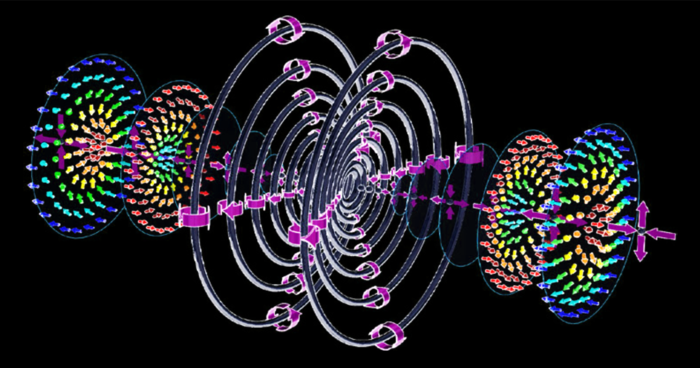Since 1890, topology in optics and photonics is known to be a hot topic where singularities in electromagnetic fields have been taken into account.
 Schematics of spatial topological structures of magnetic vortex rings and skyrmions in a supertoroidal light pulse. The gray dots and rings mark the distribution of singularities (saddle points and vortex rings) in magnetic field, large pink arrows mark selective magnetic vector directions, and the smaller colored arrows show the skyrmionic structures in magnetic field. Image Credit: Yijie Shen (2021).
Schematics of spatial topological structures of magnetic vortex rings and skyrmions in a supertoroidal light pulse. The gray dots and rings mark the distribution of singularities (saddle points and vortex rings) in magnetic field, large pink arrows mark selective magnetic vector directions, and the smaller colored arrows show the skyrmionic structures in magnetic field. Image Credit: Yijie Shen (2021).
The new award of the Nobel prize for topology developments in condensed matter physics has resulted in a renewed surge in topology in optics with the most recent developments in forming condensed matter particle-like topological structures in photonics.
In recent times, topological photonics, particularly the topological electromagnetic pulses, give hope for nontrivial wave-matter interactions and offer extra degrees of freedom for data and energy transfer. But so far, the topology of ultrafast transient electromagnetic pulses had been largely undiscovered.
In a new paper published in Nature Communications, physicists from Singapore and the United Kingdom report a new family of electromagnetic pulses, known to be the precise solutions of Maxwell’s equation with toroidal topology, in which topological complexity could be constantly monitored, specifically supertoroidal topology.
The electromagnetic fields in such supertoroidal pulses possess skyrmionic structures as they tend to propagate in free space with the speed of light. Skyrmions are advanced topological particles originally suggested as a unified model of the nucleon by Tony Skyrme in 1962. It acts like nanoscale magnetic vortices having spectacular textures.
They have been extensively studied in several condensed matter systems, such as liquid crystals and chiral magnets, as nontrivial excitations exhibiting great potential for data storing and transferring. If skyrmions have the ability to fly, they uncover countless possibilities for the next generation of informatics revolution.
This is the first know examples of propagating skyrmions. The fundamental topological constructs previously observed as spin formations in solids and localized electromagnetic excitations in the nearfield of metamaterial patterns.
Nikolay Zheludev, Professor and the Project Supervisor, University of Southampton
The supertoroidal pulse is a generalization of the supposed “Flying Doughnut,” a toroidal single-cycle pulse having space-time non-separable structure with links to vector singularities and non-radiating anapole excitations.
The supertoroidal pulse exhibits highly complicated fractal-like toroidal topological structures, displaying electromagnetic field configurations with matryoshka-like singular shells, skyrmionic structures of numerous skyrmion numbers and multiple singularities in the Poynting vector field joined by multi-layer energy backflow effects.
Furthermore, the topological complexity can be regulated by increasing the supertoroidal order of the pulse increases. Such results tend to propose supertoroidal pulses as a playground for the study of topological field configurations and their dynamics.
In this study, the topological features of the supertoroidal pulses presented offer extra degrees of freedom that can find applications in various fields, like information encoding or decoding schemes. This involves optical trapping, structured light, manufacturing by light and particle acceleration.
We believe this is the first time that the skyrmionic structure is proposed in ultrafast structured pulses, and the multiple skyrmionic structure with various textures exist in the instantaneous electromagnetic field of a supertoroidal pulse.
Dr. Yijie Shen, Study Lead Author, University of Southampton
Shen added, “Such photonics skyrmionic structures harness intriguing sharp spatial features, promising the potential applications in high-precision metrology and superresolution imaging.”
This work paves the way for several interesting opportunities for the study of light-matter interaction, topological optics and ultrafast optics with supertoroidal light pulses (for example, coupling to electromagnetic anapoles and localized skyrmions) and their applications in superresolution metrology and imaging, information and energy transfer.
Journal Reference:
Shen, Y., et al. (2021) Supertoroidal light pulses as electromagnetic skyrmions propagating in free space. Nature Communications. doi.org/10.1038/s41467-021-26037-w.